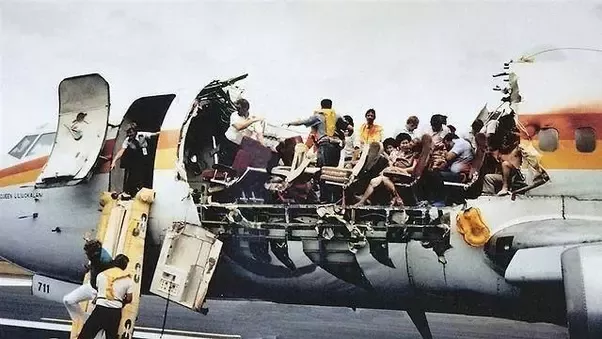On April 28, 1988, Aloha Airlines Flight 243 took off from Hilo Airport in Hawaii, heading to Honolulu. This flight was routine for the Boeing 737-297 aircraft, which had been a dependable plane for Aloha Airlines for many years. The airline, known for its reliable service, had built a strong reputation for safety and efficiency.
Flight 243 had 89 passengers and six crew members on board. The aircraft, registered as N73711, had been in service since 1969, accumulating numerous flight hours. Aloha Airlines, headquartered in Honolulu, had been operating since 1946 and was a key player in Hawaii’s inter-island air travel, offering frequent connections across the islands.
However, this flight would become one of the most significant events in aviation history. Midway through the flight, at an altitude of 24,000 feet, a catastrophic failure occurred. A large portion of the aircraft’s roof tore away, exposing passengers and crew to the open sky. This sudden decompression created an immediate life-threatening situation.

In the cockpit, Captain Robert Schornstheimer and First Officer Madeline “Mimi” Tompkins were faced with a dire emergency. Despite the chaos, they remained calm and focused. Their priority was to control the plane’s descent and ensure its stability. The decompression had caused a loss of hydraulic systems and instruments, making their task even more challenging.
Inside the cabin, flight attendants, despite being injured, managed to help passengers put on oxygen masks and secure themselves. The cabin was exposed to extreme winds and cold temperatures, adding to the chaos.
Captain Schornstheimer and First Officer Tompkins skillfully guided the damaged aircraft, executing an emergency descent and successfully landing at Kahului Airport on Maui. Their extraordinary efforts were crucial in preventing a complete disaster.
As the plane landed, airport emergency services quickly mobilized. Firefighters, paramedics, and other rescue personnel converged on the runway, ready to help. Medical teams were immediately deployed to treat the injured passengers and crew, ensuring that everyone received the care they needed.
The National Transportation Safety Board (NTSB) launched an investigation to understand what went wrong. They examined the aircraft’s structure, maintenance records, and interviewed the crew and passengers.

The investigation revealed that the catastrophic fuselage failure was primarily due to metal fatigue, worsened by maintenance issues. The aircraft had undergone thousands of takeoff and landing cycles, leading to the weakening of its structure.
In response to the findings, significant changes were made in the aviation industry. Inspection procedures were revised, especially for older aircraft. The Federal Aviation Administration (FAA) introduced stricter guidelines for regular inspections, including advanced testing techniques to detect small cracks and other structural problems. Maintenance schedules were updated to ensure more frequent and thorough checks.
The incident also highlighted the importance of crew training. The successful emergency landing by Captain Schornstheimer and First Officer Tompkins underscored the need for well-trained flight crews. This led to enhanced training programs focusing on emergency response and communication under stress.
The Aloha Airlines Flight 243 incident served as a wake-up call for the aviation industry, prompting substantial improvements in safety standards. It reminded everyone of the need for continuous vigilance, innovation, and adherence to best practices to ensure passenger safety. The lessons learned from this incident have contributed to making air travel safer and more reliable today.

